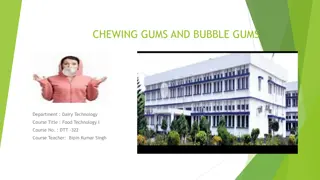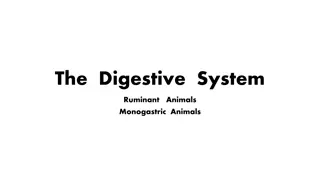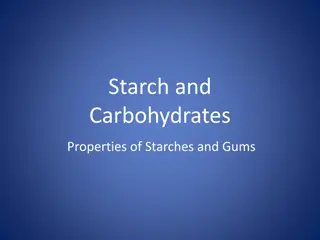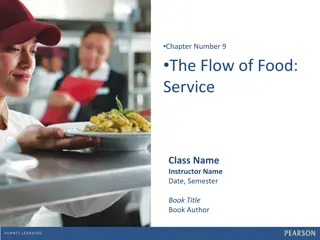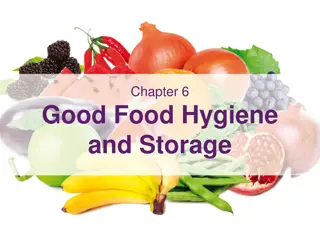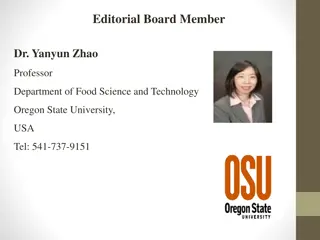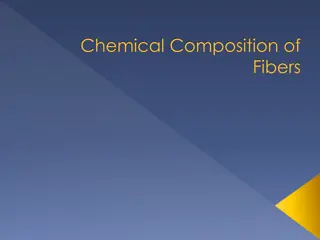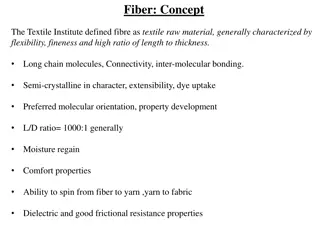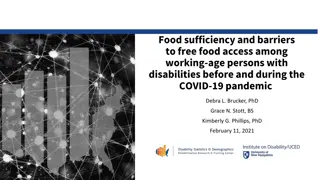Starches, Cellulose, Gums, and Pectins in Food
Explore the roles of starches, cellulose, gums, and pectins in the diet. Learn about their structures, functions, and how they affect food texture and properties. Discover how these components bind, thicken, and provide structure in various food preparations.
Download Presentation

Please find below an Image/Link to download the presentation.
The content on the website is provided AS IS for your information and personal use only. It may not be sold, licensed, or shared on other websites without obtaining consent from the author.If you encounter any issues during the download, it is possible that the publisher has removed the file from their server.
You are allowed to download the files provided on this website for personal or commercial use, subject to the condition that they are used lawfully. All files are the property of their respective owners.
The content on the website is provided AS IS for your information and personal use only. It may not be sold, licensed, or shared on other websites without obtaining consent from the author.
E N D
Presentation Transcript
Starches, Cellulose, Gums and Pectins
Starches carbohydrate in diet. Starches most abundant complex Composed of glucose Main dietary source in U.S. is wheat flour Nature s reserve carbohydrate supply
Cellulose Cellulose - known as fiber in the diet Provides bulk in food good for digestive functioning Cannot be a food source for humans like it is for cows or termites since humans lack the digestive enzymes needed to digest Forms rigid structure of plants strings in celery and membranes surrounding kernels of corn are largely made up of cellulose.
Gums Gums available commercially for Thickeners Stabilizers Trapping color and flavor Example: gum arabic used in salad dressings and gummy candies
Pectins sugar acid that causes hydrogen bonding between negatively charged molecules resulting in thickened structure. Pectins occurs naturally in fruit; Key component in jams and jellies Basic recipe for jams and jellies 1% pectin, 60-65% sugar, and 34-39%crushed fruit or fruit juice.
Provide structure ability to thicken when heated and gel when cooled enables foods containing starch to take and hold many shapes. Provide structure the starch s
Bind carbohydrates tend to hold two other substances together Amylose or amylopectin molecules hold batters to vegetables and meats during deep-frying. If allowed to set 20 minutes before frying, binding is increased due to chemical reactions that take place. Bind as a binding agent, complex
Thicken This function is possible because of Thicken starch can thicken liquids. Starch s chemical structure The size of its molecules The way it reacts to heat
Term used by food scientists to describe thickening a liquid with starch. As the temperature increases, so does the swelling of the granule structure. The temperature at which maximum swelling occurs is the gelatinization point point at which starch will hold the most water and the greatest thickening power. gelatinization point. This is the
Applying heat to a starch-water mixture causes it to thicken (gelatinization). As heat is added, starch opens up or stretches which allows water molecules to slip in the much larger starch molecules. Heat increases the amount of water that can be trapped which will make the mixture become thicker.
Salt and sugar can interfere with thickening process by decreasing the strength and viscosity of the gel.
Each starch has different physical properties Food scientists must determine which type of starch is best for a given food product. Five properties are evaluated: Retrogradation Viscosity Stability Opacity vs. translucency Texture
Starch and liquid combinations can be 4 types: Slurries starch Slurries uncooked mixtures of water and Sols pourable. Examples: pancake, waffle and muffin batter. Cooked sols include white sauce and gravy. Sols thickened liquids they are
Pastes liquid that have very little flow, but thin enough to be spread easily. Example: the start of making a gravy Pastes thickened mixtures of starch and Gels stability is controlled by controlling the linear amylose starches and the branched amylopectins Gels starch mixtures that are rigid. The
Retrogradation during cooling and standing. Occurs because starch granules are trying to return to the structure they had before cooking. Desirable when it causes a gel to thicken during cooling. Undesirable if it continues to the point that cracks form in the gel. Ex. Gravy uncovered in refrigerator several days will develop these. Retrogradation the firming of a gel
Retrogradation (continued) An important factor is serving temperature. If serving a sauce immediately, then cook to desired thickness. If served at room temperature, finish cooking while it is still thinner as it will thicken as it cools.
Viscosity mixture to flow. Food scientists run viscosity tests to measure how foods such as ketchup will flow. Viscosity is the resistance of a
Stability mixture to remain constant over time and temperature changes. Waxy maize starch example of a stable starch when frozen or heated. It is a clear, soft paste that is as thick hot as cold. Cornstarch has more thickening power than flour; smoother in texture; makes appetizing mushroom gravy. But it does not reheat well Stability is the ability of a thickened
Opacity vs. Translucency how much an object blocks light. Cornstarch, potato starch, and arrowroot produce gels that are more translucent. Good to use in fruit sauces, fruit pie fillings, and glazes that are translucent. Wheat flour is best used in chowders and white sauce. Opacity vs. Translucency refers to
Texture do with mouth feel. Texture in this context has mostly to Example: most people would not care for whole wheat flour being used to make a sauce or gravy because the texture would not be very smooth.
Starch can be added to liquid to make a thickened sauce three basic ways. In each method, starch granules are separated to prevent lumping. Cold water paste Starch and fat Starch and sugar
Cold Water Paste prevent lumps when thickening a sauce: Cold Water Paste a method used to Quickly stir an equal amount of cold water and starch. Continue stirring until a smooth paste is formed. Then more liquid such as broth can be added to make a gravy.
Starch and Fat granule with melted fat: An equal amount of starch is added to heated fat. Once starch is stirred into the fat, the liquid can be added SLOWLY, stirring constantly to keep the sauce smooth. This method is used in making white sauce and gravy from meat drippings. Starch and Fat separate the starch
Starch and Fat (continued) Professional chefs often thicken soups and sauces using: Buerre manie of solid fat and starch mixed together. These balls can be added to hot soups to thicken the broth. The balls can be prepared ahead of time and refrigerated for several days or frozen for several months. Buerre manie is a ball of equal amounts
Starch and Fat (continued) Cajun cooks commonly use a roux to thicken sauces or gravy: Roux fat until it turns a rich red-brown. Toasting the flour adds a distinctive flavor. Needs low heat and constant stirring while browning the starch to prevent burning or uneven browning. Roux is a gravy that has had the starch heated in
Starch and Sugar this method: First thoroughly combine the starch and sugar. Starch and Sugar to avoid lumps with Then gradually add the liquid with constant stirring. Used most often in sweet sauces and puddings. Presence of sugar also reduces the viscosity of the liquid and the resulting gel will be tender and smooth rather than rigid.
Starches divided into two categories: digestible starches and indigestible fiber. Starches like sugar provide 4 calories/gram Most abundant and economical source of calories available to people. Carbohydrates should provide over 50% of your daily caloric intake. Carbohydrates in the form of glucose is the only energy source your brain can use.
Excess carbohydrates are stored as glycogen. The liver stores about 33% of total glycogen. The muscles store the other 66.99% glycogen. Fiber provides bulk contributes to feeling full, aids digestion and elimination. Fiber sources include whole grains, fruits and vegetables.
Nutritional Functions of Starches addition to providing energy, carbohydrates: Nutritional Functions of Starches in Provide bulk for digestive process Tie up bile acids, decreasing their re-absorption Lower cholesterol levels in the blood, retarding atherosclerosis Promote the utilization of fat





